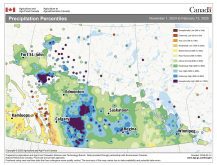Country will need high quality durum with a high percentage of hard vitreous kernels, for which Canada is known
The top buyer of Canadian durum is poised to harvest a disappointing crop.
Poor rainfall in the winter months has hampered crop development in Morocco, causing “significant and irreparable yield losses” to the country’s cereal crops, according to a United States Department of Agriculture report on the country’s grain and feed crops.
“The lack of adequate rainfall discouraged farmers from investing in in-season fertilizers and pesticides because of the anticipated low yields,” stated the report.
The USDA forecasts 1.24 million tonnes of durum production, a 49 percent drop from the previous year.
Read Also

China’s grain imports have slumped big-time
China purchased just over 20 million tonnes of wheat, corn, barley and sorghum last year, that is well below the 60 million tonnes purchased in 2021-22.
Wheat imports in 2019-20 are expected to be up 20 percent to 4.8 million tonnes but a lot of that will be common wheat.
Morocco has bought 442,800 of Canadian durum through the first seven months of 2018-19, followed by the U.S. at 396,600 tonnes and Italy with 249,800 tonnes.
Bruce Burnett, director of markets and weather with Glacier’s MarketsFarm, said Morocco has been real dry.
“The non-irrigated crops like durum would be in trouble there,” he said.
“It’s going to mean strong durum import demand.”
Morocco buys high quality durum with a high percentage of hard vitreous kernels, which is what Canada has to offer.
Algeria has fared better than Morocco with soil moisture conditions similar to last year. If it receives more rain in the next few weeks the crop should fill quite nicely.
The USDA said satellite-based vegetation maps indicate the crop is in good shape in that country.
“Based on all assessments, if good climatic conditions continue the crop should be good,” stated the USDA.
It forecasts 3.95 million tonnes of all wheat production and eight million tonnes of imports, which is nearly identical to last year.
Tunisia is heading for a bumper crop of wheat, according to the USDA. Growers planted 1.73 million acres of wheat, 88 percent of which is durum.
“The crops appear to be in overall good condition at present with good vegetation growth and no significant pest or disease issues,” stated the USDA.
It forecasts 1.13 million tonnes of durum, a 17 percent increase over last year, but some analysts think production could be up as much as 50 percent.
Tunisia isn’t as big an importer as Morocco and Algeria. The USDA is forecasting 1.75 million tonnes of total wheat imports in 2019-20, down eight percent from the previous year.
Burnett said the European Union’s crop mirrors what is happening in North Africa.
There is trouble in Spain, which is directly north of Morocco. Dry conditions will likely limit production in that country.
Crop prospects are better in Italy and Greece, which are located north and east of Algeria and Tunisia. Both countries have received decent rainfall in the last month.
There is also some relief coming on the supply side of the 2019-20 market outlook.
The USDA is forecasting 1.42 million acres of U.S. durum, a 31 percent decrease from the previous year.
Statistics Canada is predicting an 18.8 percent drop in Canadian plantings to five million acres.
“The anticipated decline in durum wheat area is the largest since 2010, when seeded area declined by more than 2.5 million acres,” stated the government agency.
Burnett is forecasting a similar decline in Canadian plantings.
“The price signals have been very strong here that farmers needed to cut back on the durum acreage globally,” he said.
Growers listened, which has created some constructive developments in the durum market compared to other cereals like spring wheat.
Durum had been trading at a discount to spring wheat but the spread has narrowed and the two crops are now around par.
But he doesn’t foresee much more price appreciation on the horizon unless this year’s export program starts out strong and the North American crop is a disappointment, which is a possibility considering Canadian growers will be planting into parched soil in places like southern Saskatchewan.















